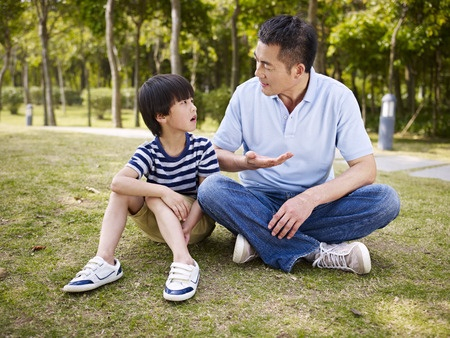
Explaining death or a tragedy to a child is one of the toughest tasks a parent will face. Find some children’s books that can help children learn about and cope with sad news, death, and grief.
It can be incredibly difficult to explain tragedy and death to a young child, and to help them cope. Whether your family is facing a personal loss of a family member or friend, or is struggling with the news of a community or national tragedy, find some children’s books that can help kids learn about coping with sad and scary news, death, and grief.
Read through the book on your own first to see if it is appropriate for your child and applies to your situation. Also, read and discuss just one book at a time with your child so that he has time to process these tough concepts. It helps to consult with your child’s pediatrician or a mental health specialist, especially in cases of a close personal loss or intense or prolonged emotions.
Looking for more? Use our Book Finder tool to search for new books for kids of all ages!
Tess’s Tree by Jess Brallier
Tess loved her tree dearly. She would swing on it and sit in its shade and catch its leaves in the fall. One day, after a storm blew off some large branches, her tree must be cut down and taken away. In the sad days that follow, Tess puts together a funeral for her tree, where old friends and admirers of it come together to share nice stories. The book is a gentle first introduction to the concepts of loss, death, and remembrance.
Recommended age: 4 and up
A Terrible Thing Happened by Margaret M. Holmes
Sherman Smith is a young raccoon who saw something awful happen. He tries to forget about it, but over time it bothers him and makes his tummy feel sick. So Sherman starts to meet at school with sweet Ms. Maple, and he learns to talk about his feelings with her, which helps him feel better. The story never goes into specifics about what “terrible thing” Sherman saw, which makes it helpful for discussing everything from natural disasters to school violence to child abuse — whether experienced personally or heard about on the news or through the grapevine.
Recommended age: 4 and up
The Invisible String by Patrice Karst
The author came up with the idea of “the invisible string” when her son started preschool in order to alleviate separation anxiety (for both mother and child). The story reminds readers that we are never alone — we are always connected to the ones we love by an invisible string, even when we are not with them. The gentle story provides comfort to children who have lost a loved one or are afraid to be away from their parents after a scary event.
Recommended age: 3 and up
Lifetimes: The Beautiful Way to Explain Death to Children by Bryan Mellonie
Discussing death with children is no easy task. This colorful, careful book explains that everything that is born also dies, and a lifetime is what happens in between. It offers a tender way of showing a child that dying is as much a part of living as being born. Note that the book says many people live to be at least 60 or 70 — which may worry children with relatives older than that, or may upset families dealing with the death of a younger loved one.
Recommended age: 5 and up
When Dinosaurs Die by Laura Krasny Brown
Parent reviews of this book are mostly glowing but advise reading only some parts of it to your child, depending on your situation. The book offers straightforward, age-appropriate answers to some common questions kids may have, such as “What does dead mean?” and “What happens after death?” (answered in a mainly secular fashion). It also explains some customs involving the dead, such as funerals. Be aware that it also covers tough topics such as suicide and drug overdoses, so gauge whether it’s appropriate to discuss those parts with your child.
Recommended age: 6 and up
Badger’s Parting Gifts by Susan Varley
This hopeful tale shows woodland animals coming together to remember their friend Badger after he dies. How will they go on? They decide that they’ll do it with the help of his gifts: his kindness, his friendship, and his love for them, which they’ll never forget. It’s a timeless, heartwarming story that doesn’t delve into specifics about death.
Recommended age: 4 and up
When I Feel Sad by Cornelia Maude Spelman
This book from the series of “The Way I Feel Books” helps teach children that all emotions are important, universal, and manageable. The warm illustrations remind children that sometimes we feel sad because something bad happened or for no particular reason at all, but feeling sad is always allowed and won’t last forever. Parent reviewers recommend reading the book not only during sad times — so that kids learn sadness can come up unexpectedly and is normal.
Recommended age: 4 and up
My Many Colored Days by Dr. Seuss
In this abstract but relatable book, children learn about the range of human emotions through a series of colorful illustrations and snappy rhymes, like: “Some days are yellow. Some are blue. On different days, I’m different too.” The colors and feelings are also associated with different animals, such as a “busy, buzzy bee” on yellow days and a horse kicking up its heels on red days. And some days are a mix of many different colors and moods — so true during times of grief.
Recommended age: 3 and up
Scaredy Squirrel by Melanie Watt
After children learn about death — either from a personal loss or a general first explanation — they are likely to feel scared at times, of things big and small. Scaredy Squirrel sure can relate. His general sense of nervousness makes him want to stay in his tree and never leave. What if there are spiders or martians or killer bees waiting for him? One day, he leaps into the unknown, and finds that there are many more good surprises than bad ones awaiting him in life.
Recommended age: 4 and up
Peaceful Piggy Meditation by Kerry Lee Maclean
Young children need some quiet time, especially after an intense event such as a death in the family or a community tragedy — or even after a plain old busy day. Balance your inquiries about how your child is feeling with some time for relaxation and reflection. This book features fun, disarming illustrations of pigs taking a break from bickering with siblings or playing video games so that they can “find a quiet spot and just breathe, breathe, breathe.” It makes the idea of meditation approachable for kids and families, rather than esoteric or far out. Sometimes, there’s nothing as therapeutic as quiet time and some deep breaths.
Recommended age: 5 and up
Only One You by Linda Kranz
This book doesn’t deal with death or tragedy at all, but it is uplifting any day of the week. It shows that kids can be proud of the fact that there is “only one you.” They should feel empowered to be themselves, feel their own feelings, make friends, create their own artwork, and live a life that is theirs. When children wonder what will happen to them or someone else when they die, they can keep in mind that every individual makes their mark on the world in their own way. No one else will ever get to be “you,” and that makes “you” so great.
Recommended age: 4 and up
Dear Mr. Rogers, Does It Ever Rain in Your Neighborhood?: Letters to Mr. Rogers by Fred Rogers
Mr. Rogers’ gentle wisdom lives on in his books. This book — a sampling of letters Mr. Rogers received from children and his actual responses to kids’ questions — is geared toward adults but would be appropriate for parents to share with their kids. It’s broken up into sections that could help during times of grief, such as “Feelings and Fears,” “Death,” and “Family Relationships.” It also includes a section on general advice to parents for answering children’s questions with honesty and sensitivity.
Recommended age: (Adult book to share with children)





